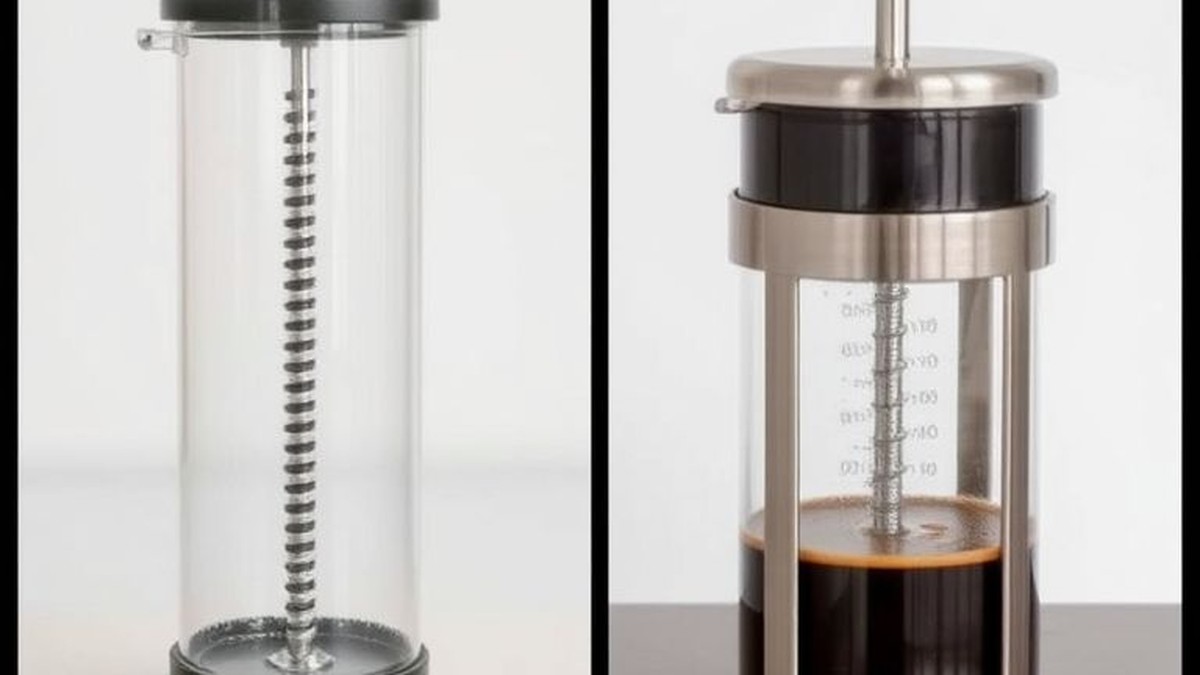AeroPress vs. French Press: Your Daily Brew Battle
Choosing the perfect daily coffee maker can feel like a quest for the holy grail of caffeine. Picture this: you’re standing in a kitchen appliance aisle (or more likely, scrolling endlessly online), torn between the sleek, modern promise of an AeroPress and the timeless, robust appeal of a French press. Do you crave the quick, clean taste of a pressure-brewed concentrate, ideal for a rushed morning or a travel adventure? Or do you long for the ritual of immersion brewing, yielding a full-bodied cup that preserves every natural oil? This comparison will help you navigate the nuances, from grind size to cleanup, so you can confidently pick the brewing companion that best suits your lifestyle.
Detailed Specifications Comparison
| Feature | AeroPress | French Press |
|---|---|---|
| Brewing Method | Immersion followed by Pressure Brewing | Immersion Brewing |
| Filter Type | Built-in stainless steel filter (reusable metal filter) | 4-level filtration system (metal mesh filter, spring disk, metal cross plate, final mesh screen) |
| Taste Profile | Bold, concentrated, smooth, clean taste, low acidity. Creates rich concentrate. | Pure, authentic, rich, full-bodied, preserves natural oils, free of sediment (with advanced filtration) |
| Brew Time | 2 minutes (hot brew) – 5 minutes (cold brew) | Typically 4 minutes |
| Grind Size Recommended | Medium-fine to Fine | Coarse |
| Cleanup | Dishwasher safe (all parts except pump). Coffee puck ejects easily. | Easily disassembles for thorough cleaning; certain parts (plunger, filter) dishwasher-safe. |
| Portability | Compact, lightweight, travel-ready, no power needed. Fits in backpacks. | Less portable due to glass carafe, more fragile. |
| Durability | Durable plastic construction, designed for travel and daily use. | High-quality borosilicate glass, resistant to thermal shock. |
| Unique Features | Rainmaker showerhead for even water distribution, creates versatile concentrates (Americanos, cold brew, affogato). | Sleek and stylish design, transparent glass allows watching the brewing process, classic aesthetic (e.g., Bodum, Cafetière). |
| Sediment Level | Minimal to none, delivering a very clean cup. | Minimal to none with advanced 4-level filtration, but traditionally associated with some fine sediment. |
| Check Price for AeroPress | Check Price for French press for daily coffee |
Design & Build Quality
When it comes to aesthetics and construction, these two brewers diverge significantly. The AeroPress boasts a utilitarian, robust design, typically made from durable, BPA-free plastic. Its compact nature and lack of fragile parts make it an ideal companion for the rugged adventurer or the minimalist kitchen. Conversely, the French press, often synonymous with brands like Bodum or Cafetière, typically features a elegant glass carafe (usually borosilicate for thermal shock resistance) cradled in a metal frame, exuding a classic charm. Its transparency allows you to witness the enchanting dance of immersion brewing.
Anecdote: My friend Mark, an avid camper, swore by his AeroPress. He once dropped it on a rocky trail during a hike, and it just bounced. “Try that with your fancy glass carafe,” he’d always jibe, and I knew he had a point. Its compact, almost indestructible build makes it the ultimate adventure companion. Yet, I remember my first French press, a beautiful Bodum model. The clear borosilicate glass always looked so elegant on my kitchen counter, catching the morning light as the coarse grounds bloomed. It felt like a ritual, watching the coffee steep, something the sturdy but opaque AeroPress couldn’t offer aesthetically.
Performance & Features
The core difference in performance lies in their brewing methods. The AeroPress, through a combination of immersion and pressure brewing, excels at creating bold, concentrated café-style coffee in a remarkably short time—as little as two minutes for a hot brew. Its unique “rainmaker showerhead” ensures even water distribution, while its built-in stainless steel filter promises a remarkably clean, low-acidity cup. This versatility means you can craft everything from Americanos to cold brew, offering a truly unique, clean taste profile. The French press, on the other hand, is the quintessential immersion brewer. Its strength lies in preserving the coffee’s natural oils and flavors, delivering a rich, full-bodied cup. Modern French presses often feature sophisticated 4-level filtration systems (including a metal mesh filter) to ensure your coffee is free of sediment and grit, a common critique of older models.
Anecdote: There was a particularly hectic Monday morning when I overslept by 20 minutes. Panic set in until I remembered my AeroPress. Two minutes later, I had a rich, low-acidity concentrate ready for my travel mug. It was a lifesaver, proving its ‘quick brew’ claim isn’t just marketing fluff. My Sunday mornings, however, are sacred. I love the ritual of grinding my beans coarsely, letting them steep in my French press for a full four minutes, and then slowly pressing down. The resulting coffee is always so full-bodied, with all the natural oils preserved. It’s an immersion brewing masterpiece, a stark contrast to the rapid, almost clinical, precision of pressure brewing.
Ease of Use & Cleanup
Both devices are relatively straightforward to use, but their cleanup routines vary. The AeroPress is renowned for its ingenious design that makes cleanup almost effortless. After brewing, you simply unscrew the filter cap, push the plunger, and a compact puck of spent coffee grounds pops neatly into the bin. Most parts are dishwasher safe, making post-brew tidying a breeze with minimal lingering sediment. The French press is also simple to operate: add coarse grind, hot water, steep, then press. However, managing the wet grounds can sometimes be a bit messier. While newer models often feature easily disassembled parts, and certain components like the plunger and filter are dishwasher-safe, getting all the coarse grounds out of the carafe can sometimes require a bit more rinsing and effort than the AeroPress’s clean eject. The metal mesh filter, while effective, can sometimes trap fine particles more stubbornly.
Anecdote: The first time I cleaned my AeroPress, I was amazed. Just unscrew the cap, push the plunger, and the compressed puck of coffee grounds pops right out into the bin. A quick rinse, and it’s done – or even better, toss it in the dishwasher. No lingering sediment, no fuss. It really embodies ‘cleanup’ simplicity. Cleaning my French press, while improved with dishwasher-safe parts, used to be a bit of a chore. Getting all the coarse grounds out of the carafe and disentangling them from the metal mesh filter could be tedious. While my current model is much easier to clean, it still requires more hands-on effort than simply ejecting a puck.
Verdict
The choice between an AeroPress and a French press ultimately boils down to your priorities:
- Choose the AeroPress if: You value speed, portability, a clean taste with low acidity, and incredibly easy cleanup. It’s perfect for travelers, busy professionals, or anyone who enjoys experimenting with concentrate-based drinks like Americanos or cold brew. Its pressure brewing method delivers a distinctive, clean cup.
- Choose the French Press if: You prioritize a rich, full-bodied coffee that celebrates the natural oils and complexity of the bean. It’s ideal for those who enjoy the ritual of immersion brewing, appreciate a classic aesthetic (like a Bodum or Cafetière), and don’t mind a slightly longer brew time or a bit more hands-on cleanup for that authentic, full-bodied experience. Modern designs minimize sediment, offering a cleaner cup than ever.
Both are excellent daily coffee makers, but they cater to different coffee philosophies. Your perfect cup awaits!

I am a passionate recipe developer and food enthusiast specializing in heart-warming traditional dishes and simple, everyday meals. My goal is to inspire you to find joy and confidence in the kitchen through my easy-to-follow recipes.
